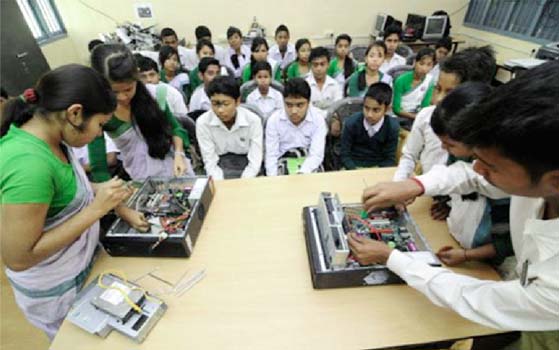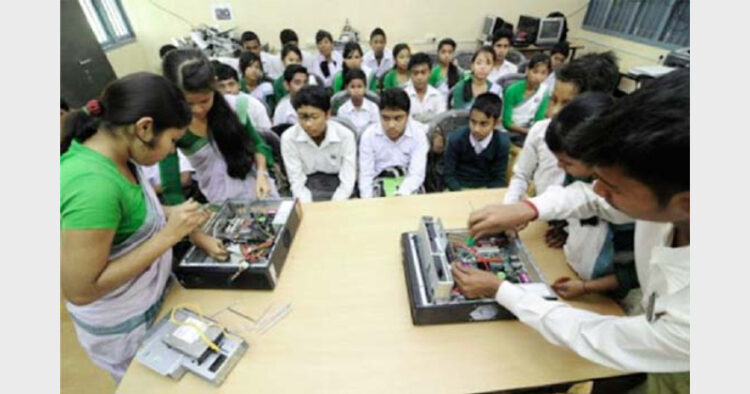The education system of post-Independence India was raised under the deep shadow of Marxist policy makers who had little faith in Indian ethos and were in awe of the ‘Socialist and Secular’ framework of politics. Given this background, the new Education Policy-2020 approved by the Union cabinet comes as a fresh ray of hope laying out the vision of the Modi government towards education
Dr Swadesh Singh

NEP 2020 paves way for internship, skills, and art since
school level, restructuring institutions of higher education
school level, restructuring institutions of higher education
When the revolutionary and reformative NEP-2020 was unveiled on July 29, many pointed out that it was the third such document to be released since Independence. A key difference was missed – while the first two were ‘New’ in spirit this 2020 vision document is ‘National’ in its energy.
India that is Bharat was considered a Vishwa Guru in ancient times. Most of the research, knowledge and innovation done by India paved the way forward for the rest of the world. This was the reason why India had the biggest economy in the world till 1700. Today, there is a government at the Centre which believes that India needs to reclaim its seat as Vishwa Guru and show the path to a world mired in existential crisis.
After Independence there were no major changes in the education system and Macaulean Minutes served as the anchor for policy makers. The education system of modern India – after the first and second education policies – was raised under the deep shadow of Marxist policy makers who have little faith in Indian ethos. These policy makers were in awe of the ‘Socialist and Secular’ framework of politics and tried to impose that frame of reference on our education system. The net result in the last 70 years has been a system that gave us millions of graduates but with minimal employability. We built a human resource pool that lacked professional skills, was indifferent to cultural ethos, and had a little formal initiation into the ethics and moral values of a modern society. Unless this gap is bridged, the demographic dividend of India could turn into demographic disaster in the coming years.
Prepared in this background, the new Education Policy-2020 which was approved by the Union cabinet comes as a fresh ray of hope laying out the vision of the Modi government towards education.
Prime Minister Narendra Modi has envisioned a prosperous and empowered India by 2047 which is only possible through an ecosystem where education, employment, entrepreneurship and empowerment go hand in hand. The National Education Policy 2020 makes way for a resurgent India by setting out to achieve the said target over the next 20 years.
Focus on internship, skills, and art since school level, restructuring institutions of higher education, renewed emphasis on innovation and research, and priority to mother tongue in elementary learning, are some of the salient points that make this education policy hugely futuristic. What is expected the most from an education system is access, quality, and affordability- NEP 2020 aspires to achieve these.
In this Information Age where knowledge economy drives the system, it is imperative to develop a robust education structure equipped with state-of-the-art learning, research, and innovation methods and tools. Put together after wide-raging deliberations over a span of five years, the NEP-2020 is a well thought out document. As far and clarity of vision and objectives are concerned, one will find it hard to punch holes. The real challenge will lie in actualisation of the policy over the coming years.
NEP sets a clear tone for education from elementary levels to research and innovation. The implementation of this vision could prove to be an arduous task as state governments come into play. The states are equal stake holders in the education sector along with the Centre. After the 42nd Amendment in 1976, education became a subject of Concurrent List – before that it was a State List subject – which means that states and the Centre, both can make laws related to education. Here arises the problem. The Centre works like a funding agency for many education schemes, especially elementary to secondary levels. For example, the policy moots addition of breakfast along with midday meals. While the Centre can fund the same, it cannot ensure that the meals are properly distributed among the right candidates.
The new education policy not only clears the way for India to become a knowledge powerhouse but also kickstarts a cultural resurgence where a decolonised young mind can be nurtured and an ecosystem for original thinking can be created
The NEP is a policy document that is not mandatory for states. Hence its implementation hinges on synergy between the Centre and states. The only two other instances when education policy was introduced were in 1968 and 1986. This was the period when the states and the Centre more or less had the same party in power hence implementation of the vision document was much simpler. In today’s time, however, with different governments in power in many states – a successful joint implementation is going to be an uphill task.
Bharatiya Shikshan Mandal welcomes NEP 2020
Bharatiya Shikshan Mandal (BSM) in a statement issued on July 29, has said that it whole heartedly welcomes The National Education Policy. “BSM looks forward to a new revolution in education through this democratic policy that is product of research of enumerable academician and aspirations of billions”, it said.
At a Conference of Academic Leadership on Education for Resurgence organised by BSM on 29 September 2018, 400 VCs from universities across Bharat seconded the proposal of renaming the ministry back to “Education and Culture”. The same has been accepted by the government, noted BSM.
A suggested move in the NEP that is expected to scale up literacy levels in a big way is pedagogical and technological intervention. The document approaches education through experiential learning and critical thinking and points to curriculum restructuring in this regard. It also attempts to break compartmentalization of knowledge by encouraging interdisciplinary studies and doing away with hard separation among arts, humanities and sciences at school level. Similarly, the hard separation between curriculars, co-curriculars and extra-curriculars is also to be done away with. It is in this vein that that the policy document also makes room for large multidisciplinary universities and colleges.
The NEP rightly lays emphasis on use of technology, given how it has revolutionarized dissemination of information and knowledge. Use of digital technology enables better reach, dissemination of study material, and absorption among learners. But while technology is a force multiplier it is also inaccessible to a large population. Hence, the first challenge is going to be to make technology available and affordable for all.
The issue of graded autonomy of colleges and invitation to top 100 universities from abroad could also present a sticky wicket for the government. Various aspects of this should be studied and cautiously implemented as the opposition forces are likely to use it to spark fear of privatization among the teaching and student community. Time and again in the past, this issue has been used by Leftist organisations to feed the core agenda of their trade union politics. The difference between professionalisation, commercialisation and privatisation should be understood properly and no chance should be given to mischievous ‘socialist-secular’ lobby to stoke discontent.
Studies world-wide have proven that the use of mother tongue in imparting education increases grasp and comprehension in young minds. In one of its most revolutionary proposals, the NEP pitches for use of mother tongue till Class 5. However, here too the government needs to step cautiously as this could be used for petty politics by regional political forces.
The move to promote Indian knowledge tradition so as to widen the scope of our learning is also landmark. It has been a long-standing demand to offset the loss of traditional knowledge in the wake of Macaulay’s approach to education. However, this could again be dismissed as saffronisation of education and opposition members could be pressured to toe the Marxist-Macaulean agenda.
It is also to be kept in mind that while the policy is drawn up by academics, the implementation lies with bureaucrats, state government and district education officers. The ideas mooted in the NEP are new, revolutionary and timely but a majority set of implementing hands are going to be old and inflexible in their ways. Taking this positive spirit of change deep into the system is the biggest challenge of it all. These changes are needed now, more than ever and quicker than in the past.
The new education policy not only clears the way for India to become a knowledge powerhouse but also kickstarts a cultural resurgence where a decolonised young mind can be nurtured and an ecosystem for original thinking can be created. So far the ability of young minds to create and think has been shackled to degrees. The NEP looks at freeing learners from these chains and making formal education a facilitator in learning instead of an impediment.
(Author teaches Political Science in Satyawati College of Delhi University, Delhi)













Comments